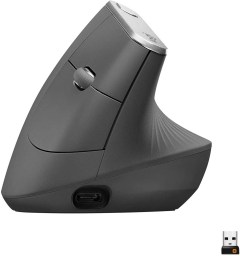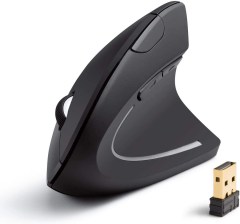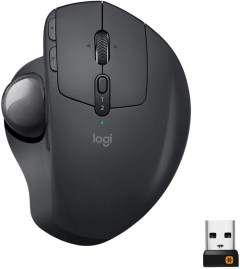
A great ergonomic mouse designed for gaming and perfect for long sessions in front of a computer.
A great ergonomic mouse designed for gaming and perfect for long sessions in front of a computer.
The wireless component makes this portable. Being a gaming mouse, it is lightweight and extremely reliable. Razer is a major computer accessory brand, and its products are trusted by millions. The charging dock means there is no need to spend money on batteries. The design allows the mouse to sit comfortably in hand.
The DPI handle can be a bit too big for some hands.

With a long-lasting battery and a great price, this wireless mouse is a great choice for anyone picking out their first ergonomic mouse.
With a long-lasting battery and a great price, this wireless mouse is a great choice for anyone picking out their first ergonomic mouse.
Great battery life allows users to continuously utilize the mouse for long sessions. It is shaped like a regular mouse which makes it perfect for beginners, and it can be linked to multiple devices. The use of a metal scroll wheel means that this part is both sturdy and reliable.
Requires users to have AAA batteries in stock.

The MX Vertical offers comfort and reliability that allows users to continue to work effectively for longer.
The MX Vertical offers comfort and reliability that allows users to continue to work effectively for longer.
The build promotes both comfort and durability thanks to the materials used and the lightweight aspect. The wireless feature makes it easier to transport. Can be paired up to multiple devices with a single button controlling the switching between devices.
The unique shape can take some getting used to.

More sensitivity than the usual optic mouse allows for wider and longer-term use, from casual surfing to hours of computer work to regular gaming.
More sensitivity than the usual optic mouse allows for wider and longer-term use, from casual surfing to hours of computer work to regular gaming.
Users report an extremely comfortable, pain-relieving ergonomic mouse that’s relatively low in cost for its functionality. The matte finish prevents hands from slipping, and there's a shorter learning curve than other mice of this type.
May be too large for smaller hands; the one surface it doesn't seem to work on is glass.

An adjustable wireless mouse that can seamlessly switch between a horizontal mouse to a vertical ergonomic design.
An adjustable wireless mouse that can seamlessly switch between a horizontal mouse to a vertical ergonomic design.
The adjustability of the mouse allows it to be used for any type of work. It also allows the mouse to become portable. It is durable and long-lasting so there will be no need to buy another mouse anytime soon. Being wireless, the mouse is easy to transport and there is no need to untangle a cable.
Suitable for right-handed use only.

We recommend these products based on an intensive research process that's designed to cut through the noise and find the top products in this space. Guided by experts, we spend hours looking into the factors that matter, to bring you these selections.

If you’re at a computer all day long, it’s important to think about ergonomics — that is, you should make sure that the gear you use every day is suited for long-term use so you can avoid the pain and complications that come with repetitive motions. For most people, that means working with an ergonomic mouse and keyboard.
Standard mice often force our hands into awkward positions to use them, in most cases twisting the wrist. Over time, that can lead to problems like pain and even carpal tunnel syndrome. In contrast, ergonomic mice are built around a natural holding position that keeps the wrist in a more comfortable straight line. With an ergonomic mouse, long-term use and repetitive motions aren’t a problem.
Whether you’re new to ergonomic mice or you just need a new one, you’re in the right place.

Before you start shopping, you can make the search easier by ruling out mice that don’t meet your needs. Here are a few questions to think about.
Will you be doing any gaming with your ergonomic mouse? If you’re a gamer, consider how responsive you want your controls to be — wireless mice can add lag time to your clicks, which can hold you back in games that require split-second reflexes. If you need a mouse connection that’s fail-proof, go with a wired ergonomic mouse.
Could you adapt to a trackball mouse? There’s no denying it: trackball mice are an acquired taste. Much like split keyboards, trackball mice are typically more ergonomic and have a small but devoted following among consumers. Trackball mice give you a plastic ball to roll around to move your mouse, which works with more natural movements than a traditional mouse. But there’s about a 50-50 chance that you’ll love it.
Are you left-handed? If you’re a southpaw, read carefully through the product listings for ergonomic mice. Some are reversible, so they can be used by both right-handed and left-handed people. If you don’t find a good universal ergonomic mouse, try searching for ergonomic mice made specifically for left-handed people.
There are all kinds of ergonomic mice, but a few models set themselves apart with some killer added functionality. Here are our favorite features to look out for.
Programmable buttons. This is a must-have feature: extra mouse buttons that you can assign to any keystroke you want. With programmable buttons, you can have one-touch access to specific key combinations. For example, you can set one button to copy, and another to paste, or you can set the extra buttons to control your computer’s volume. The sky’s the limit with programmable buttons, and the convenience is real; in other words, don’t buy an ergonomic mouse without them.
Adjustable PPI. Pixels-per-inch, often referred to as PPI, is how computer mice measure how precise they are. A mouse’s PPI gauges how many pixels the mouse will move on a screen when it’s physically moved one inch. High-PPI mice allow for precise control, which makes a difference for both gamers and digital artists. If you regularly use any application where pixel-perfect mouse placement matters, get an ergonomic mouse with adjustable PPI and manually set it to your needs.
Bluetooth connectivity. Most ergonomic mice come with USB dongles that allow them to wirelessly communicate with your computer. Although that’s the norm, it means using up an open USB port on your machine, which may be problematic if you’ve already got other things plugged in. To remedy this, some ergonomic mice have built-in Bluetooth, so they can use your computer’s existing Bluetooth connectivity instead of using up a USB port. If you don’t have any spare USB ports on your computer, but you still want to use an ergonomic mouse, find one with Bluetooth, and you’re good to go.

It’s easy to find a quality ergonomic mouse for anywhere between $15 and $30. Whether you’re looking for a straightforward ergonomic mouse with lots of extra buttons or a trackball that will last forever, you don’t need to spend a ton. There are a lot of good models to be found for under $30.
If you’re buying an ergonomic mouse to address a problem with pain or based on your doctor’s recommendation, look at ergonomic mice that cost between $75 and $100. Ergonomic mice in this price range are made with high-quality materials and include premium features like high PPI settings.
If you’re planning on buying a new wireless keyboard in addition to your ergonomic mouse, consider buying a mouse-and-keyboard bundle. Wireless keyboards and mice are often packaged together and offered at a discount, but the real win is getting a set where both components rely on the same wireless USB adapter. Buying them separately could mean needing to use two different ports, which can be a tall order, especially on laptops.
If you’re trying a different type of mouse for the first time, give yourself a month to adjust. It can take a little while to get used to a new ergonomic mouse, especially if you’ve been using a different kind of mouse for quite a while. Give it a chance — developing new habits is hard, especially for muscle memory.
Find out what type of batteries your ergonomic mouse uses — then make sure to always keep extra on hand. Most ergonomic mice use AA or AAA batteries. Get in the habit of changing your batteries regularly, and keeping spares on hand, so you never get caught mouse-less in an important situation.


Q. Will a USB 2.0 ergonomic mouse be fast enough for everyday use? Is it better to buy a USB 3.0 model?
A. Either will be fine. While it’s true that USB 3.0 is a faster standard than USB 2.0, ergonomic mice don’t really need the extra speed from the newer standard. While the difference matters when it comes to large data transfers, you’ll never notice the difference with a mouse.
Q. If I get an ergonomic mouse, do I still need to use an ergonomic mouse pad or wrist rest?
A. It depends. A good ergonomic mouse will keep your wrist from twisting, but depending on how it’s designed, you may want to elevate your wrist anyway. Refer to recommendations in the instructions — but if your wrists or any part of your hand are sore after using it, that’s a potential sign you may need the extra help of a wrist rest. As with anything pain-related, you should consult with your doctor if a problem persists.
Q. How often should I expect to change the batteries on an ergonomic mouse?
A. Batteries in ergonomic mice last a long time — sometimes up to two months, depending on how frequently you use the mouse. While it’s never a bad idea to keep a spare set of batteries around, you can also take comfort knowing that with an ergonomic mouse, you won’t have to constantly be changing batteries.
Get emails you’ll love.
Learn about the products you’re wondering if you should buy and get advice on using your latest purchases.
